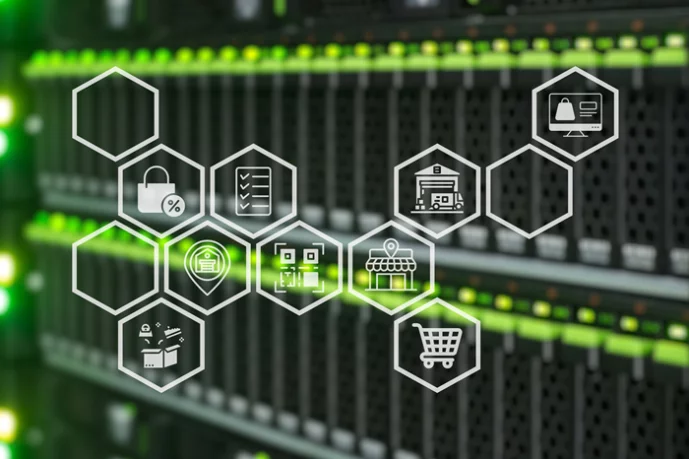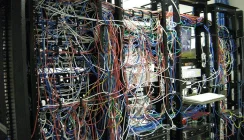How to Make Your Server Room More Sustainable
Most UK businesses are adopting environmental sustainability practices. Whilst the main driver may be to reduce energy consumption (and operating costs), approximately one in ten are aiming to reduce their carbon emissions (electricity usage) and water consumption.
Large data centre operators have in recent years seen more pressure to reduce their climate impact. Over the next 5 years, we believe smaller operations including server rooms with 10-20 or less server racks will also face similar pressures. Their goal will be to meet corporate sustainability and energy efficiency objectives whilst trying to ensure IT system resilience and business continuity.
Sustainability and Energy Efficiency
The two terms ‘sustainability’ and ‘energy efficiency’ are complimentary but have different meanings:
- Sustainability: the United Nations Brundtland Commission in 1987 defined sustainability as “meeting the needs of the present without compromising the ability of future generations to meet their own needs.” Not an easy task when you consider that almost 140 developing countries are looking at how they can meet their development needs, with the increasing threat of climate change, whilst ensuring their development today does not negatively affect future generations. The UK government, for example has a ‘net zero target’ to ensure the UK reduces its greenhouse gas emissions by 100% from 1990 levels by 2050.
- Energy Efficiency: energy efficiency is a percentage ratio of the useful power output from a system divided by the total put input. Taking the percentage from 100, show the gap or ‘wasted’ energy. To improve energy efficiency, you need to use waste less energy to achieve the same or a higher output.
Improvements in energy efficiency contribute towards sustainability and environmental goals. Sometimes though it is a trade-off. Upgrading to more energy efficient systems is one way to improve energy efficiency but this can have less benefit to sustainability objectives if the legacy systems cannot be recycled easily or enough materials recovered for reuse.
More information
https://www.un.org/en/academic-impact/sustainability
https://www.eesi.org/topics/energy-efficiency/description
How to Make Server Rooms Greener
At Server Room Environments we believe you need to ‘protect, monitor and control’ operations within a server room environment. As with any management system there needs to be a ‘plan-do-check-act’ mindset:
- Plan: determine goals for a system/process and the needed changes to achieve them
- Do: implement the changes
- Check: evaluate the results in terms of performance
- Act: standardise and stabilise the change or begin the cycle again, depending on the results
For a data centre or server room this could interpreted as defining the goals to be reached by a specific date to ensure they are SMART (specific, measurable, accurate, relevant, and time-bound). typical energy efficiency goals. The most obvious is energy efficiency but how to do you calculate this for server room systems and which are the most critical systems to consider?
Critical Power and Cooling Systems
The biggest operational cost for a server room is electricity usage, measured in kWh. For cooling, a typical server room uses an air conditioning. If water cooled server rack doors are used, then water usage, measured in litres, cubic-metres, or gallons, come into play but this rare in small server rooms. Water-based cooling is typically the preserver of larger data centre operators.
For large data centres, a typical cooling system includes cooling towers, chillers, piping, and computer room air conditioners (CRACS) and air handlers (CRAHs). All to deliver a constant cooled temperature and humidity level. Most systems use evaporative cooling that removes and releases heat into the outside environment. To give an example a hyperscale data centre with evaporative cooling can use 10-15,000 gallons of water a day and this water must come from a ‘local’ source which can impact the region it operates within.
The two most important critical infrastructure systems to consider therefore include:
- Uninterruptible Power Supplies and Generators
- Air Conditioners
The typical operational or useful life for a UPS system or air conditioning system is 10 years and this is if the system is regularly serviced under a maintenance contract. Standby generators can have longer (15 years or more) and again only when maintained.
Green UPS Systems
Over the last decades these technologies have been developed by manufacturers to meet demand for more efficient and less environmentally impactful systems. This opens opportunities for organisations to meet their efficiency and environmental goals.
UPS systems for example can achieve 96-99% operational efficiency over a wide operating load rang (down to as low as 25%) with modular systems providing the enhances functions of module sleep modes and reduced battery charging. When you consider that a legacy system would probably have a 75-80% efficiency, the savings in operational kWh consumption can be considerable.
Environmentally Friendly Air Conditioning
Air conditioning systems have followed a similar development path to produce greener or more eco-friendly systems. Not just in terms of energy usage but also the coolant used. R32 has become increasingly popular as a cooling agent because of its low global warming potential and higher energy efficiency. R32 has a low GWP (global warming potential) and is easier to recycle than other refrigerants including R410A which are being phased out.
Most small server rooms rely on wall mounted ‘split’ air conditioners. Where there are multiple server cabinets, precision cooling may be an option in the form of in-row cooling systems. With in-row cooling, the air conditioning units are close coupled with the server cabinets, to ensure they provide cool air to the front of the server racks and consume the warmest return air possible. The approach allows for low-to-high density server racks while also increasing air conditioning efficiency and managed cooling.
Eco Friendly Generator Fuels
In terms of generators, think about the transition to lower/zero carbon fuels in transportation including electric vehicles. What can be done to make generators more environmentally friendly?
Typical alternatives to diesel include biofuels and natural gas. Not only do they emit lower carbon dioxide emissions. They also emit less harmful pollutants than traditional diesel. Noise levels and odours (other forms of pollution) can also be reduced with acoustic canopies, exhaust systems and fuel choice.
For standby generators for server room and data centre UPS, Hydrotreated Vegetable Oil (HVO) is now the most popular choice. HVO is a diesel-like fuel that can be produced without fossil resources by processing renewable waste lipids.
Electricity Sources and Renewable Energy
Today the UK electricity market offers contracts for power generated via renewable energy sources. Alternatively, a business or organisation may be able have their own local on-site generation and energy storage. This could be used to power the building housing the server room, but it is unlikely, that for a small server room, that the renewable power generation system will be large enough. This latter approach may be more suitable for larger data centre operators who can secure and invest in the necessary land required for their own solar farm or wind turbine farm.
Server Rack Arrangements and Airflow Management
One of the easiest ways to improve energy efficiency in a server room is to look at the airflow management. This can be as simple as ensuring that server racks have side panels, doors, and blanking panels (to improve the front-to-rear airflow) to re-arranging the server racks themselves.
It is considered best practice to present cool air (from the air conditioning system) to the front a server rack and then to manage the flow within the server rack, as the air heats up and exhausts through a return path to the air conditioner input. Hot and cold-aisle containment can help to manage air flow effectively when there are multiple server racks.
Turning up the room temperature also helps. The ideal temperature for a server room is 18-25°C. Some rooms overcool below 18°C and this just wastes energy. Most IT servers and storage devices will operate up to 30°C or more. The only caveat is to be aware of the heat-impact on critical systems such as uninterruptible power supplies and their batteries. Valve Regulated Lead Acid (VRLA) batteries require an operating ambient of 18-25°C for their design life calculations (5year or 10year). Lithium-ion batteries are less temperature sensitive, however.
Thermal cameras are sometimes used by our projects team to identify hot or overcooled areas. Thermal mapping techniques can also be used to model the room including computational fluid dynamics (CFD).
IT Load Optimisation
What is your IT load? Most organisations now operate a hybrid-cloud strategy. Local servers, storage and connectivity is provided by the onsite server room with cloud-based servers used for other operations. For some installations, their on-premises operations have become Edge computing sites.
For those organisations this means that their IT operations are smaller than their room and systems were originally designed for. This opens the potential to reduce the IT space to be cooled and install smaller, more energy efficient infrastructure systems including uninterruptible power supplies and air conditioners.
IT load optimisation can also include managing operations more effectively over non-productive times. This reduces idle load energy consumption over weekends and holiday periods for non-critical systems. Intelligent PDUs and IP power switches provide remote reboot and power-up/down calendar facilities that can assist this type of energy saving measure. They can also help to measure the kWh usage of the connected loads as well as other power related information and communicate this via SNMP or Modbus or other protocols to third party monitoring platforms (including DCIM packages) and manufacture specific software (on-premises or cloud-based).
Environmental Monitoring Systems
An environmental monitoring system can help a business or organisation to reduce its operating costs. The AKCP sensorProbe+ monitoring platform provides a way to proactive monitor an environment 24/7 with automatic notification alerts when a sensor threshold is exceeded, or a digital input (DI) signal is received. The most installed sensors in an IT environment include temperature, humidity, and flood & water leakage. Others that can be useful include air flow to detect whether an air conditioner is functioning as intended or not, smoke/fire, security, and power including (presence, voltage and current).
A combination of sensors is always recommended to provide comprehensive monitoring of the room and any change in operation by a critical infrastructure system. Any changes instantly lead to a notification alert (email, SMS, SNMP, or phone call) via a suitable protocol and connection method.
Changes and alarms can be immediately responded to reducing response times, allowing corrective actions to be taken and data to be saved. A fast response to alert notifications can also reduce the time to respond, save operations costs, engineer and service technician time and reduce waste energy. An environmental monitoring solution also helps to ensure business continuity and resilience and maintain uptime and reputation.
A sudden increase in room or rack temperature can indicate overheating and cooling system failure. As well as a threat to IT system integrity, employee safety could also be comprised by high temperature and humidity levels. Water leakage from local sanitation pipes or a cooling system or nearby flood can lead to mold build-up or even worse cause a short-circuit and fire.
Reports from an environmental monitoring can also be generated from the stored data logs. This can help to comply with industry standards, incident investigation and used for reports including business continuity, sustainability, and energy usage.
Energy Meters
With a suitable environmental monitoring system, virtual sensors can be used to show the measured data from local sub-distribution energy meters (single and/or three phase metering). These can be zoned for a complete building and specific high usage areas such as a server room or data centre hall. The energy meter data can include all AC or DC parameters including power and energy related and the stored data used for comparison and metric calculations including power usage effectiveness (PUE). Typical data available from a connected energy meter can include:
- Phase to Neutral Voltage (V)
- Phase Current (A)
- Frequency (Hz)
- Power Factor (PF)
- Power Max. Demand (MD kW)
- Active Power (kW)
- Reactive Power (kVAr)
- Apparent Power (kVA)
- Import Active Energy (kWh)
- Export Active Energy (kWh)
- Total Active Energy (kWh)
- Import Reactive Energy (kVArh)
- Export Reactive Energy (kVArh)
- Total Reactive Energy (kVArh)
The energy-related measurements may also be available via a manufacturer’s cloud-hosted platform such as Rayleigh connect. The local installation requires mobile gateways to connect to the cloud platform.
E-Waste Management and Reduction Strategies
Electronic waste or e-waste is a generic term used to describe old, end-of-life, discarded electrical and electronic equipment, including hardware commonly found in server rooms. Items range from servers and monitors, to routers, modems, server racks, UPS systems, air conditioners and server racks.
How these items are recycled or disposed off affects the sustainability goals for a business or organisation. E-waste can contain toxic additives and hazardous substances that must be disposed of in well-managed waste streams with disposal certificates and recycling documents provided as proof.
Where systems can be repurposed, they should be to reduce landfill and greenhouse gas emissions. An organisation with a 3year IT server upgrade for example could take out an extended warranty and run its servers for 5years. Over a 10year cycle this would remove at least one set of servers from the replacement-disposal cycle.
Summary
There are many ways for a business or organisation to make their server room greener. For some sites, quick wins can include adjusting room temperatures and improving airflow management. For others, the age of their critical infrastructure systems requires a more detailed plan, but one that will generate a considerable reduction in operational costs.
Please contact our Projects Team to discuss how we can improve the sustainability and energy efficiency of your server room or data centre operations. From energy metering to critical power and cooling system upgrades, to environmental monitoring systems, we provide a complete project management service.


























